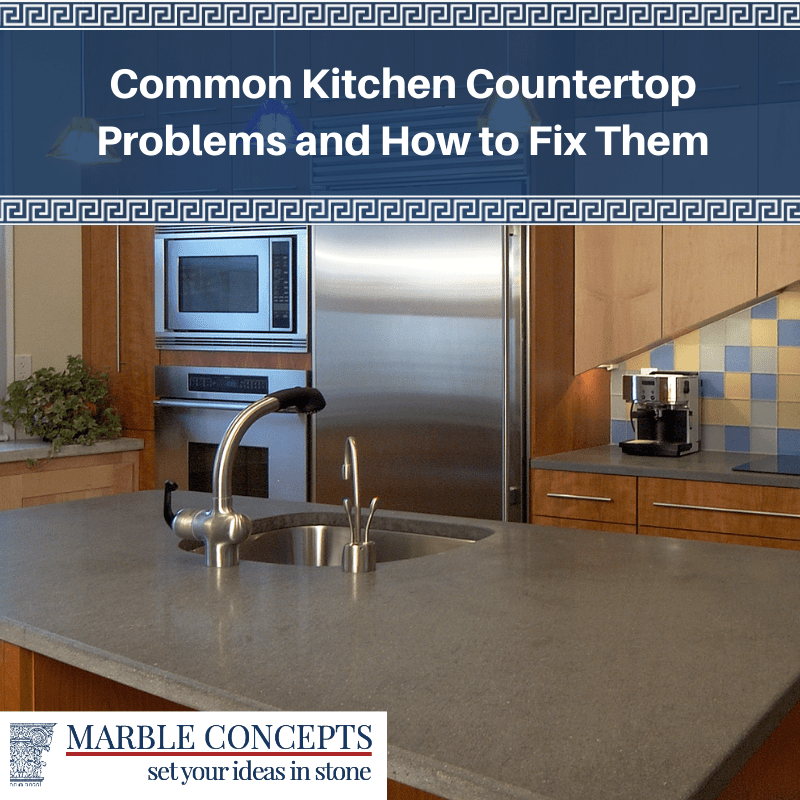No matter how durable your kitchen countertops may be, they may still develop problems over time. With proper maintenance, countertops should have fairly long lives. However, even if you do everything right with your countertops, a problem could develop. Rather than try to cover up the problem with decorative items, it may be possible to perform a simple countertop repair to get your countertops back to their original condition.
Countertop Rupture
A rupture in a countertop may appear to be catastrophic damage and most homeowners feel they will have to replace the entire counter when this occurs. A rupture can happen for several reasons. They may have been installed over an uneven surface or the joints may not have been crafted properly. If the glue was not given proper time to dry or if your counters have too much weight in one spot, they could rupture as well. If the rupture is small, adhesives recommended by the manufacturer may resolve the problem quickly. If the damage is large, the section of the countertop will need to be removed and a special filler applied to fill in the damage.
Edge Cracks
Heavier countertops need support from your cabinets and if they were installed without enough reinforcement, cracks could develop along the edge, especially if you have heavy appliances or other features installed that could break down the material. You may also need to install specially placed vents for appliances that exert heat, like toaster ovens, to prevent the heat from damaging your surfaces.
Water Damage
Although any type of countertop can be damaged by water, it is more common on laminate or wooden counters. Signs that your counter has been damaged by water are a dishwasher door that does not close properly or if the counters are no longer even with the cabinets. One way to prevent water damage is by applying a vapor barrier, especially under your sink and around your dishwasher. Check for leaks in your pipes under the sink and under your dishwasher, filling any you find with caulking seal.
Dull Surface on Stone
Stone countertops do not handle harsh cleansers well and using them can cause your countertop surface to look dull. Harsh cleaners on marble can cause this to happen fairly quickly while other stones, like granite, take time for the surface to dull. It is possible to bring the high shine you loved back to your stone counters. However, this is not something you should attempt on your own. Contact a local fabricator, like Marble Concepts, to perform your kitchen countertop repair. They can buff and repolish your counters to bring back the shine. When it is time to clean your stone counters, you really only need to use mild soap and water. There are special cleaners designed for stone, and although they may cost a little more, they are specifically formulated to protect your counters.
Heat Stains
Hot pans taken directly on the stove should never be placed on laminate or wood countertops. Although most stone countertops will withstand high heat, engineered or soft stones, like quartz and marble, cannot, and even though granite is heat resistant, trivets or hot pads are still recommended. If you accidentally place a hot pan on your counter and cause damage, you may be able to repair it in a few simple steps. If your counter is laminate, apply a layer of toothpaste to the surface with a rubber spatula after cleaning it well. Let the toothpaste sit for 10 minutes or so, then, using a soft-bristled brush, like a toothbrush, scrub the stain. When the stain is gone, wipe it with a fresh moist towel. Heat stains on stainless steel can be removed with club soda rather than toothpaste while a heat stain on a porcelain counter can be removed with baking soda and water.
Water Stains on Stone
If your water is rich in minerals, it could leave a white, crusty residue on your counters. The counters may also appear to have grimy residue that no cleaners seem to remove, it may be water stains. Use a gentle cleaner and soft-bristled brush on the spot. You can also use steel wool to get a stubborn stain. If these tips don’t work, you can purchase a specially made poultice for stone that is a thick paste you apply to your counters. Cover it with a plastic sheet secured with tape around the edges and let sit for 24 hours. Remove the plastic and rinse the counters.
Scratches and Chips
No matter how careful you are with your countertops, accidents can happen. A pan can fall from the cabinet and crack the edge of your counter or someone could cut up an orange directly on the surface of your counter, leaving knife marks. If your counter is laminate, you can purchase a specially made pen or paste to fill in scratches. If your counter is granite, the repair is much more difficult. Mark off the area with the scratches with masking tape so only the damaged area is visible. Apply an epoxy resin mixed with color pigments to match your granite and apply to your damaged area with a stick. Build up the mixture higher than the rest of the counter surface. Scrape off the excess filler with a razor blade to create a smooth finish. Place clear tape over the resin which forces it deeper into the crack or chip and then remove the tape as the manufacturer recommends. Sand the area, first using 200-grit, then 800-grit, and finally 2000-grit, remove the masking tape, polish the area, and buff it before cleaning with a soft rag.
Although it is possible to perform your own countertop repair, in many cases it is better to call a professional. If you are in need of kitchen countertop repair, contact Marble Concepts today to see how we can help. You can arrange for a no-obligation consultation by calling or filling out the easy online form.






